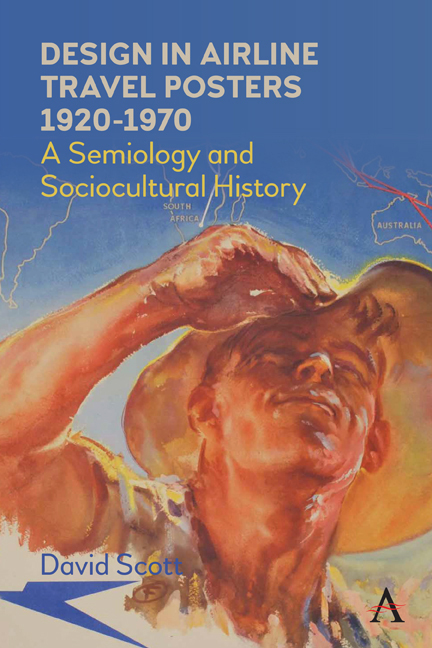Book contents
- Frontmatter
- Dedication
- Contents
- List of Figures
- Introduction
- 1 Fact and Fantasy: Reading and Misreading the Poster Image
- 2 People, Places and Planes: Destinations and Itineraries
- 3 Looking Out and Looking Up: Framing Devices and Indexical Signs
- 4 Indigenous Peoples
- 5 Glamour and Sex Appeal: Designing Desire
- Conclusion: The Decline of the Airline Travel Poster
- References
- Index
- Frontmatter
- Dedication
- Contents
- List of Figures
- Introduction
- 1 Fact and Fantasy: Reading and Misreading the Poster Image
- 2 People, Places and Planes: Destinations and Itineraries
- 3 Looking Out and Looking Up: Framing Devices and Indexical Signs
- 4 Indigenous Peoples
- 5 Glamour and Sex Appeal: Designing Desire
- Conclusion: The Decline of the Airline Travel Poster
- References
- Index
Summary
Airline posters of the interwar period of the twentieth century constitute as rich a source of insight into European colonialist propaganda as any other cultural production. As in postage stamps (see Scott, 1995: 73–85; 2002: 45–53), their primary function – a sign of mail and place of posting for stamps; a sign of destination and means of travel for airline posters – is supplemented more or less subtly by a range of colonialist themes including sexual voyeurism, exoticism, racial fascination and developmental zeal, designed to appeal to the Western (and in particular the Western male) viewer. These themes are mostly presented under the cover of a scientific alibi provided by ethnography, a discipline that burgeoned in Europe in the nineteenth and early twentieth centuries, precisely as the continent's colonial enterprise was reaching its peak. Ethnographic study sets out to analyse and classify the variety of native types; their customs, myths and rituals; and their natural environment. The privileging of the naked or near-naked native body as a focus of attention activated a process that could become, when the images were decontextualized, as rich a source of imaginative reverie as of objective knowledge. Ethnographic discourse and visual documentation are thus prone to be used as a cover for sexual fantasy as well as for economic domination and racial prejudice. The aim of this chapter will be to explore the way such strategies are exploited in interwar French and British airline posters, using as a point of comparison the elaboration of similar themes in 1920s and 1930s stamps issued by these countries’ African colonies.
Although Africa (with the exception of Cape Town) lacks the glamorous cities of other equatorial, tropical or subtropical continents – Rio in South America, Hong Kong in the Far East, Sydney in Australia – it makes up for it by a multitude of destinations offering a range of exotic settings – jungle, river, lakeside village, palm-fringed shore. Such sites quickly became the staple settings of interwar airline poster images produced by Britain and France as they sought to give colour and substance to the strange names – Bamako, Dakar, Togo – that the colonial itineraries of their national airlines served. But the airline poster's main appeal was, as in the postage stamps of the interwar colonial period, primarily built around their presentation of native types – naked or semi-naked, male or female – involved in ritual or traditional activities.
- Type
- Chapter
- Information
- Design in Airline Travel Posters 1920–1970A Semiology and Sociocultural History, pp. 83 - 96Publisher: Anthem PressPrint publication year: 2021



